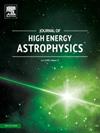f(Q,T)引力对电荷致密星形成的影响及其对低质量间隙区质量半径关系的约束
IF 10.5
4区 物理与天体物理
Q1 ASTRONOMY & ASTROPHYSICS
引用次数: 0
摘要
本文探讨了f(Q,T)引力框架下的带电各向同性恒星模型。通过推导修正场方程的解,我们系统地分析了恒星构型的物理特征,以评估其相关性和稳定性。我们的结果表明,电荷分布符合规则性和有限性的关键准则。值得注意的是,电荷行为受到电荷参数σ和耦合参数m的显著影响,同时对n的变化表现出稳定性。我们发现表面电荷的范围在1.85×1020 C到3.31×1020 C之间,这与先前的研究结果一致,突出了电荷在维持恒星抗引力坍缩稳定性方面的关键作用。此外,我们对密度和各向同性压力的分析表明,这两个量在核心是有限的和规则的,有效地消除了奇点的存在。中心密度与典型的中子星结构一致,而各向同性压力在边界处趋近于零。研究了因果关系条件,我们确认声速保持在亚光速,绝热指数Γ(r)超过临界阈值43,表明整个恒星结构都是稳定的。力的平衡,通过修正的TOV方程来评估,说明了引力、静电力和流体静力之间的和谐平衡。质量和半径之间的关系表明,最大质量在1.83 ~ 2.99M⊙之间,半径与观测数据一致。总之,我们的发现强调了电荷参数σ在提高高质量致密恒星的致密性和稳定性方面的重要影响,为质量间隙区域内恒星的存在提供了支持。本文章由计算机程序翻译,如有差异,请以英文原文为准。
Implication of f(Q,T) gravity on the formation of the charge compact stars and constraining their mass-radius relations in lower mass gap region
In this paper, we explore a charged isotropic stellar model within the framework of gravity. By deriving solutions to the modified field equations, we systematically analyze the physical characteristics of the stellar configuration to assess its relevance and stability. Our results show that the electric charge distribution adheres to key criteria of regularity and finiteness. Notably, the charge behavior is significantly affected by the charge parameter σ and the coupling parameter m, while demonstrating stability in response to variations in n. We find that the surface charge ranges from C to C, which is consistent with prior research, highlighting the crucial role of electric charge in maintaining stellar stability against gravitational collapse. Additionally, our analysis of density and isotropic pressure reveals both quantities to be finite and regular at the core, effectively eliminating the presence of singularities. The central density aligns well with typical neutron star configurations, while the isotropic pressure approaches zero at the boundary. Investigating the causality conditions, we confirm that the sound speed remains subluminal, and the adiabatic index exceeds the critical threshold of , indicating stability throughout the stellar configuration. The equilibrium of forces, evaluated through modified TOV equations, illustrates a harmonious balance among gravitational, electrostatic, and hydrostatic forces. The relationship between mass and radius indicates a maximum mass ranging from to , with radii that are consistent with observational data. In conclusion, our findings underscore the substantial impact of the charge parameter σ in enhancing the compactness and stability of higher-mass compact stars, providing support for the existence of stars within the mass gap region.
求助全文
通过发布文献求助,成功后即可免费获取论文全文。
去求助
来源期刊

Journal of High Energy Astrophysics
Earth and Planetary Sciences-Space and Planetary Science
CiteScore
9.70
自引率
5.30%
发文量
38
审稿时长
65 days
期刊介绍:
The journal welcomes manuscripts on theoretical models, simulations, and observations of highly energetic astrophysical objects both in our Galaxy and beyond. Among those, black holes at all scales, neutron stars, pulsars and their nebula, binaries, novae and supernovae, their remnants, active galaxies, and clusters are just a few examples. The journal will consider research across the whole electromagnetic spectrum, as well as research using various messengers, such as gravitational waves or neutrinos. Effects of high-energy phenomena on cosmology and star-formation, results from dedicated surveys expanding the knowledge of extreme environments, and astrophysical implications of dark matter are also welcomed topics.
 求助内容:
求助内容: 应助结果提醒方式:
应助结果提醒方式:


